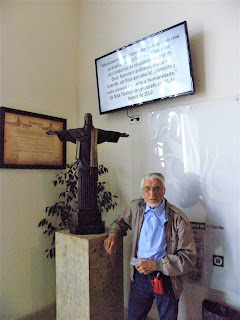But are they really similar? They look similar for two reasons:
-they’re both red;
-they’re both suspension bridges.
The suspension bridge is on the south west border of Lisbon, and spans over the Tagus river (Tejo river in Portuguese). The bridge connects Lisbon to Almada, the city where you’ll find the Cristo Rei Monument.
The “Golden Gate Bridge of Lisbon” was built by the same company that built the Oakland Bay Bridge in San Francisco (but didn’t build the Golden Gate Bridge). If you look closely, you’ll see that the suspension bridge of Lisbon actually looks a lot like the Oakland Bay Bridge; the pillars are built the same way, with the crosses in the middle. So is the Ponte 25 de Abril a Golden Gate Bridge replica? Not exactly, but it sure looks a lot alike.
Some quick & interesting few facts about the Ponte 25 de Abril :
- Construction of the bridge started in 1962 and took 4 years, with the bridge officially opened on August 6th 1966.
- The bridge was initially called “Ponte Salazar” (Salazar Bridge), named after Portugal Prime Minister (and dictator) Antonio de Oliveira Salazar.
- In 1974, at the end of the Carnation Revolution, people removed the name of The Dictator Salazar of the bridge from one of the pillars and wrote “25 de Abril” in paint, an homage to the day the revolution started.
- How long is the bridge in Lisbon? - The 25 de Abril bridge is 2.2 km. (2,277 meters) long (7,470 feet).
- The bridge was built by the American Bridge Company who contrary to popular belief is not the same company that built the Golden Gate bridge in San Francisco.
Cristo Rei (Christ the King) is a Catholic monument of Jesus Chris and shrine located in the city of Almada, across the River Tejo, overlooking Lisbon.
Inspired by Rio’s famous Christ the Redeemer statue, the 110 metre-tall Cristo Rei (about 360 feet and 11 inches) was erected in 1959.
The views from the statue are stunning, with Lisbon spreading before you. On a clear day, you can see as far as Pena Palace in Sintra, some 20 kilometres (12 miles) away.
Facts about Cristo Rei:
-At 110 metres (or 360 feet and 11 inches), the statue itself is 28 metres tall (or 91 feet and 10 inches). The tower of the 25 April Bridge is 190 metres high (or 623 feet and 4 inches).
-The statue of Christ was hand-sculpted at 100 metres high (328 feet).
-The Christ with open arms is facing Lisbon. The arches that support the statue are facing each of the four cardinal directions.
-Inaugurated on 17 May 1959, construction began ten years before, on 18 December 1949.
-40 thousand tons (or 80 million pounds) of reinforced concrete provide stability to the monument.
-Cristo Rei was built at an original cost of 20 million escudos (or €8 million).
-The Portuguese Cristo Rei was inspired by the statue of Christ the Redeemer on Corcovado Mountain in Rio de Janeiro, Brazil.
-Christ the Redeemer is an Art Deco statue of Jesus Christ in Rio de Janeiro, Brazil, created by French sculptor Paul Landowski and built by Brazilian engineer Heitor da Silva Costa, in collaboration with French engineer Albert Caquot. Romanian sculptor Gheorghe Leonida fashioned the face. Constructed between 1922 and 1931, the statue is 30 meters high, excluding its 8-metre pedestal. The arms stretch 28 meters wide. The statue weighs 635 metric tons, and is located at the peak of Corcovado - 700-metre high.
-Location: Corcovado mountain, Rio de Janeiro, Brazil.
-Height: 30 meters (98 ft) and 38 meters (125 ft.) with fundament.
-There are replicas of the statue of Christ the Redeemer in 18 more other countries (Vietnam, Nigeria, Timor, Poland, Bolivia, etc.).
We drove through the Teijo Bridge with Margy with our new Peugeot 304 in 1978, bur didn’t stop to climb the Christo Rey de Almada monument. Now 40 years later we drove with Vasko, Tania and Vasko Junior 3 or 4 times and went especially to see and climb Christo Rey. I took a lot of photos and downloaded some more representative from Internet. The best of them are shown in this album.







album.



































































